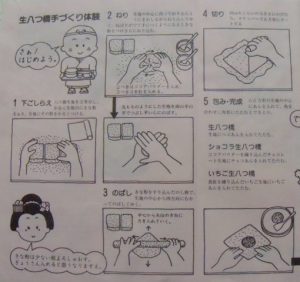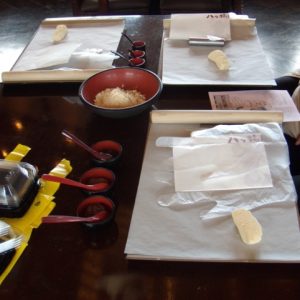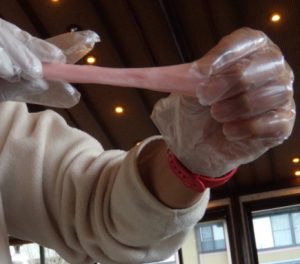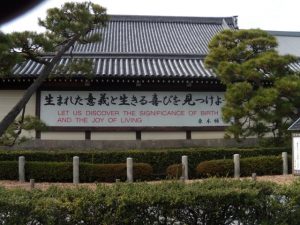Konichiwa こんにちわ +++ Greetings from Kyoto,
Today our class went on a field trip accompanied by two of the Senseis from Kyoto Minsai Japanese Language School. We took the subway to a small shop that makes Yatsuhatchi; a traditional sweet from Kyoto that is made from rice paste, cinnamon and soy flour. Inside are different sweet fillings.
This little doll is the mascot of the shop. +++ Below are my class mates from Kyoto Minsai. The word Minsai means “all of us together”. The school’s policy is fellowship rather than competition. The class I am in is a short term class. A student may attend the short term classes for as brief a period as 2 weeks up to 3 months. The school also offers longer term classes too with a more serious program of up to 2 years study. If you attend a longer term course the school will help you get a cultural visa to stay in Japan for a more extended time than the standard tourist visa of 3 months.
There are a variety of fillings that are placed inside Yatsuhatchi such as chocolate, sweetened bean paste and different types of fruit fillings. The rice batter that the confectionary is made of is the same type of material as Mochi. Traditionally, the cooked rice was beaten with wooden hammers on a raised stone mortar. In modern times however an industrial food mixer is used to beat the rice paste until it becomes a glutenous batter.
Below is the beginning set up to make Yatsuhatchi. The portion of raw dough is cut into small pieces. Beside the tray you can see the bowl of soy flower and the small dishes of fruit, bean and chocolate filling. There is also a wooden dowel that functions as a rolling pin. After the batter is kneaded by hand until it is softened and gains elasticity it is then rolled with the dowel until it is flattened out like a small tortilla. The wooden dowel is covered in soy flour to prevent the batter from sticking. The tortilla shaped piece is cut into a square, then the filling is added. Though they are entirely different pastries, the shape of the finished Yatsuhatchi is formed like an Empanada, which are deep fried pastries that are Spanish in origin but can be found in Mexico and other Latin American countries.
Yatsuhashi is a famous Kyoto sweet. It was named after Kengyo Yatsuhashi, a well-known koto player and composer of koto music. The koto is a long, 13-stringed instrument that is plucked like a harp or a guitar. In 1689, four years after Yatsuhashi died at age 72, a sweet that was shaped like a koto was named after him — “yatsuhashi” — and began to be sold on the approach to Shogoin Shrine. Soon after, the sweets began to be called “Shogoin yatsuhashi”. The main shop that made these confections was Genkaku-dou. “Gen” means “black,” and it was also used as a common name for Konkaikoumyou-ji Temple, which Kyoto people also referred to as “Kurodani-san” (“black valley”). “Kaku” means crane, and the cry of the crane is similar to the sound of a koto. This store has been in business for over 300 years. Around 1905, yatsuhashi became a popular Kyoto souvenir among Japanese visitors to Kyoto. At that time, vendors stood outside Kyoto Station and sold packages of yatsuhashi. (Chiaki, 2006)
There are two types of yatsuhashi: baked and unbaked. Generally, most people think of yatsuhashi as baked. Unbaked yatsuhashi is called “hijiri.” The ingredients used to make baked yatsuhashi are only pounded rice with a little bit of cinnamon and sugar added for flavor. Baked yatsuhashi has been around since 1689 and is like a crisp cracker. Now it is made by machine, but until 1970 it was handmade and baked on a hot plate. During WW II, yatsuhashi couldn’t be made because of the scarcity of rice. (Chiaki, 2006)
Hijiri, or unbaked yatsuhashi, began to be sold around 1960. To make this kind of yatsuhashi, rice flour is kneaded with hot water and steam; it is then mixed with sugar, cinnamon, and sometimes poppy seeds and finely rolled out flat. It is then cut into 8cm x 8cm squares and soybean flour is sprinkled on both of its sides. Azuki red bean jam is placed inside, and then the hijiri is folded over to form a triangle. These days three new flavors have been added to the traditional taste of zuki red bean jam: macha (powdered green tea), strawberry, and peach. (Chiaki Imanaka, April 16, 2006, viewed, 1/20/2016, http://thekyotoproject.org/english/shogoin-yatsuhashi/ )
Take care my friends, life is short, ++++ the message of the photo below expresses impermanence.
Gassho,
Andrew
PS:
Below is a sign at the Kyoto Shin Buddhist Temple, Higashi Hongonji +++ Higashi Hongonji means Eastern Honganji. Basically, there are two schools of Shin Buddhism, East (Higashi) and West (Nishi). There are numerous sects among the Shin Buddhists, but East and West is the basic division. When I need a RESET, I like to visit Higashi Hongonjji. The place radiates deep transcendental peace. When I am near Kyoto Station, I usually drop in there. I go inside and get a folding chair from the stack and sit Zazen in the back. They have a noon service that is beautiful. During the service there is singing and incense offerings. The thought expressed on the sign below is inspirational. So much so, I wanted to share it with you. I hope you all have enjoyed this photo essay. +++ AA






